Yes, please do!
| White Canker Forum |

|
December 04, 2025, 06:57:59 am

|
|||
|
|||
| News: SMF - Just Installed! |
| White Canker Forum |

|
December 04, 2025, 06:57:59 am

|
|||
|
|||
| News: SMF - Just Installed! |
| Home | Help | Search | Login | Register |
|
1
on: March 14, 2013, 12:04:35 am
|
||
| Started by Don Peters - Last post by Don Peters | ||
|
Yes, please do!
|
||
|
2
on: March 13, 2013, 05:26:52 pm
|
||
| Started by Don Peters - Last post by CamKrist | ||
|
Similar subject was being discussed at yahoo answers last week. I can post the link if needed.
|
||
|
3
on: August 23, 2010, 03:50:34 pm
|
||
| Started by Don Peters - Last post by Don Peters | ||
|
During the past week, I've been walking around my property, checking out the plants and trees. While doing this, I noticed that the bark mulch didn't look like it should look. So I examined it more closely. Then I checked out all the areas I had put down bark mulch. To my great surrpise, all the bark mulch had disappeared, and all that remained was a thin coating of wood chips! I'd never seen this happen before. Normally I find that bark mulch will disappear, or rot, after a year or so. Now, its life seems to be two months!
Noticing this, at first I was almost in disbelief. Then, as I thought about it, it seemed to make sense. White canker infiltrates the inner bark of a tree, soaking up the nutrients that should instead go into nourishing and creating the outer bark. That nourishment includes the infusion of anti-decay chemicals into the outer bark. If you carefully examine trees infected with white canker, you will see that the bark often looks unhealthy, as if it is in a state of partial decay. This unprotected bark is what goes into bark mulch. Soil bacteria (and white canker fungus), then, has a much easier time of digesting this bark mulch, and it takes advantage of it, especially when moisture is present. The other component of typical mulch, wood chips, isn't attacked much by white canker, so it remains on the ground after the bark disappears. I've always liked the look of bark mulch, along with its moisture retention. But it looks like I'm going to have to find a substitute. I've tried grass, cocoa shells and wood chips, but I'm not fond of any of the bunch. So I'm still looking. |
||
|
4
on: August 15, 2010, 05:12:42 am
|
||
| Started by cmiller - Last post by Don Peters | ||
|
Ah, yes, Cynthia Ash. She came to look over my trees and shrubs in 2005. She seemed very nice during the visit. But I later had some doubts about her diagnosis, and called to discuss them with her on the phone. She seemed very upset and somewhat angry that I would dare to question her, and she then refused to spend any more time with me discussing the subject! I was somewhat taken aback by this as I come from an engineering and science background, and try to seek out as much evidence as I can before coming to important conclusions. So it's no surprise to me that she "refused to look at your site". As for me, I'm willing to look at all evidence and to see where it leads.
Yes, I too am mystified by so many "experts" in the field giving a shoot-from-the-hip diagnosis when they have little to go on. It gives me the impression that plant pathology is more like a black art than a science! I like the statement made by the late tree expert Dr. Alex Shigo, who said something like "I listened to the trees, and I listened to the experts, and they disagreed - I decided to believe the trees". I'd love to hear from Bill Stringfellow and discuss this disease with him. I'll let you know if he contacts me. As I said in another posting, I'm not testing Agrifos, as I'm just now completing my testing with Propiconazole and Pentra Bark. I don't recall the mix ratio at the moment, but I believe I still have enough for two more treatments of my yard (about 25 shrubs and trees), which might do me for the season since I apply every 3 weeks or so. I think one cost me $12 and the other was $30, so that would be about $40-50 per season. Our local lawn and tree care company will do the spraying for you for about $100 per treatment, so maybe that would be something like $700 per season. That's fairly expensive (at least for me). But, you do also get insect protection thrown in when they do the treatment. On the other hand, I find that my combo treatment makes the trees healthy enough that they seem to be able to better defend themselves against insect pests, so I'm not seeing a need for insect control on my treated trees and shrubs. |
||
|
5
on: August 13, 2010, 08:57:39 pm
|
||
| Started by cmiller - Last post by Don Peters | ||
|
Trunk splitting...
I'm still not certain what causes the trunk splitting in white canker. In fact, I don't recall ever reading why any canker caused bark splitting. But from what I've seen so far when examining white canker fungus within bark and under a microscope, it appears that there is a race going on between the phloem (inner bark) and the fungal material - each wants to gain the upper hand and dominate. This seems to lead to thickening of the phloem. At the same time, due to lack of nourishment, outer bark can't grow. The result seems to be a split in the outer bark. Something in the soil... Yes, its entirely possible that something in the soil can kill the chestnut fungus. Same with white canker fungus, as my website describes under the "Lazarous plant". This "something" may be some sort of bacteriophage - a virus that kills specific kinds of bacteria. I think that's also the ultimate answer for eliminating white canker. But right now it's just a wish. The people who support bringing back the chestnut trees (I'm one of them), are banking on selective breeding to come up with a blight-resistant chestnut tree. But I'm not hopeful that that will work with white canker, as it seems to infect virtually all trees and shrubs. The only thing totally resistant to white canker I've seen so far is viburnum leaves (but the wood/branches are highly susceptible). Chestnut web page... What impresses me about this web page is the willingness to freely discuss and try a variety of disease treatment approaches. A while back I spent many many hours doing Google searches for information on Sudden Oak Death (phytophthora ramorum). While I found many web pages dealing with it, the vast majority were simply rehashes of existing information. I found almost no information about people trying to treat it by experimenting with various fungicides. I found no pictures of what it looked like under a 400x microscope. While this disease was spreading rapidly, I found no discussion or experimentation on exactly how it propagated/reproduced. Most sites seemed content to just publish pictures on what affected trees looked like, and how bad it was. Agrifos... I haven't tried Agrifos, so I have no idea on its effectiveness on white canker. I really only have the means to try one fungicide at a time. Right now I'm testing a Propiconazole and Pentra Bark combination as a "trunk drench". I've tried about 4 or 5 treatments over the summer on my trees and shrubs, and on two of my relative's trees and shrubs. Experience so far shows it to be successful, so I plan to publish details on this website soon. Possibly next summer I'll try something else, such as Agrifos and Pentra-Bark. My goal is to find something that is relatively low cost, easily applied, doesn't damage the trees, and is not a threat to people, groundwater, or animals. |
||
|
6
on: August 11, 2010, 04:37:26 am
|
||
| Started by cmiller - Last post by cmiller | ||
|
I went a-googling <tree blight> and <tree fungi> to get a broader overview of tree diseases and how they manifest. I was struck by images i found of the effects of chestnut blight. The affected chestnut trees exhibit a very similar splitting/expansion of the bark around the bole of the tree, and the rampant shoots sprouting from the soil line. I read that there's something in the soil that prevents the chestnut blight fungus from penetrating beneath the soil, which is why the trees keep sprouting after the main tree dies back to the ground.
I imagined if this blight works as rapidly as the chestnut blight, but affects so many more species...oh, lawdy... I found this webpage, which is all the more interesting considering your empirical experiences with chemical treatments of propiconazole and Agrifos, and because fungicides aren't supposed to be effective on Verticilllium wilt.  I'd be interested to hear how the Agrifos is working out for you, now you've had more time to evaluate. Better/worse than propicanazole? Cost analysis for the two types? |
||
|
7
on: August 11, 2010, 04:20:17 am
|
||
| Started by cmiller - Last post by cmiller | ||
|
I wanted to finish up with my experience with the trees.
I submitted samples to the ag extension agent, which were transferred to MSU, Bozeman, for examination by a researcher there. The extension agent and a retired plant pathologist came to look at my site last week. The plant pathologist said she's been on your site, Don; her name was Cynthia Ash. She is not too fond of you and refused to look at your site, though i urged it and mentioned the microscopic images.  Cynthia seemed fairly convinced my trees are suffering from Verticillium wilt, so took more samples to attempt to culture it. I tend to think that's not right, since the same wilt on which she's an expert, Verticillium albo-atrum and Verticillium dahliae, should also have affected my tomatoes and potatoes just feet away, which were not affected. The researcher in Bozeman dismissed the lengthy account in a CD i'd sent along with the samples, which gave a history of the site, soil type, the species affected, and so forth. With no evidence, she refuted my explicit statements about having planted them at the proper depth, though Cynthia admitted they were planted at the proper depth. The researcher said i'd fertilized too heavily and probably poisoned them with Dicamba, all of which is rubbish. There's no mention in her report of ever viewing the samples under a microscope. Another woman from my community garden group who also submitted samples along with mine was told the bark damage to her trees was "mechanical". Like she has a 3'-tall lawnmower.... There's more, like their asking me why i just don't switch to junipers instead, but it's too disheartening to go into. Suffice it to say, i completely understand your frustrations with the authorities after getting my hopes up that these scientists would be impartial and thorough. I ordered Pentra-Bark from your source, and applied propiconazole in a trunk drench last Thursday. I called Bill Stringfellow about whether he'd sent the samples he intended. He'd gotten my email with the mailing info and this site's URL, but hadn't acted on it. He said he was going to be in the NE before long, and that he might possibly contact you when he is. I heartily recommended it. Let me know if he follows through, would you? FYI: i called Stringfellow also to get the proportions of PR to propiconazole per gallon. Bill told me to use 2-3 oz. of propiconazole and 2 oz. of PB per gallon of water. I'm curious what ratios you are using with the Agrifos, if you don't mind telling me. I've worked out that i'll be spending about $30 a month to protect my trees, if this even works. |
||
|
8
on: August 03, 2010, 06:40:58 am
|
||
| Started by Don Peters - Last post by cmiller | ||
|
Hi, Don. I wanted to report that when i was at Home Depot last Friday, i saw a bag of the Scott's mulch, dyed brown, was split, so i took a good whiff. It smelled pleasant, so either this batch came from a different source, or it was processed/stored differently. I wonder if it can mold in the bag...?
|
||
|
9
on: July 30, 2010, 09:40:36 pm
|
||
| Started by Don Peters - Last post by Don Peters | ||
|
If you've looked closely at many silver maple trees, you know why they call them "silver" - their bark is a silver color. And you've also probably noticed that the bark is shaggy and covers the entire trunk of the tree. White canker makes this description less true now. One characteristic of white canker is that it eats away at the inner bark, the phloem, and prevents the creation of new outer bark. Furthermore, chemicals that protect the outer bark from decomposition are also not produced. So, as a tree grows, the old bark decays away, and instead of new bark you get a poor substitute. In addition, the loss of chemical decay resistance means lichens are more likely to colonize the bark.
The previous posting mentioned this bark issue. This posting will show you some examples of it. Here's the first example: 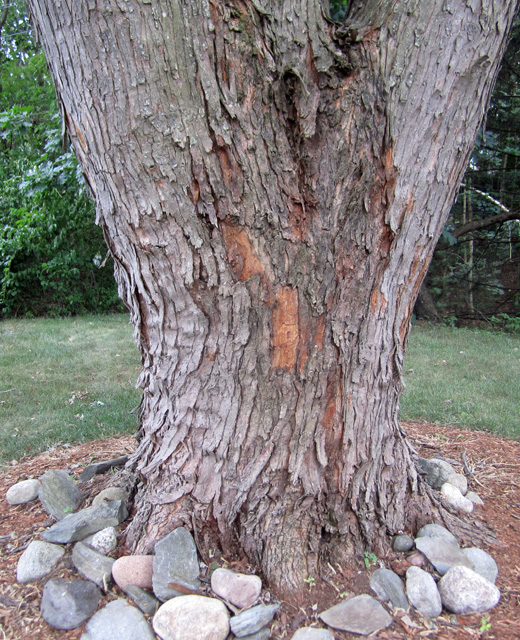 To see a full-resolution version of this photo, click on www.whitecanker.net/pictures/2010-07-25 Silver maple-1 bark.jpg (Left click to zoom in to a point, right click to save the picture to your PC or to print it.) The first time you notice this, you will probably think somone has peeled the bark away. But then, as you more carefully examine these bare spots, you'll see that the underlying bark doesn't look healthy at all. Here's another silver maple with the same problem: 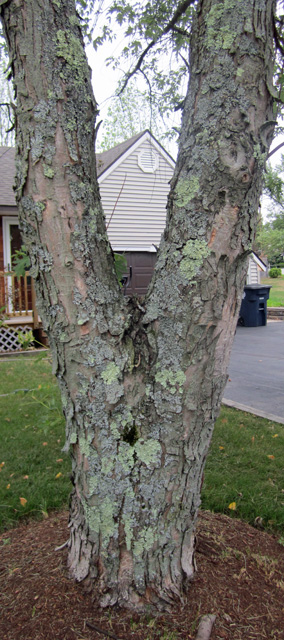 To see a full-resolution version of this photo, click on www.whitecanker.net/pictures/2010-07-25 Silver maple-2 bark.jpg (Left click to zoom in to a point, right click to save the picture to your PC or to print it.) As you look at the remaining bark, you can see that it is losing its silver color, and instead turning black. The areas where the bark has fallen away often take on a light brown, or "peanut butter" color. This silver maple hasn't lost too much bark yet, but it's getting there. 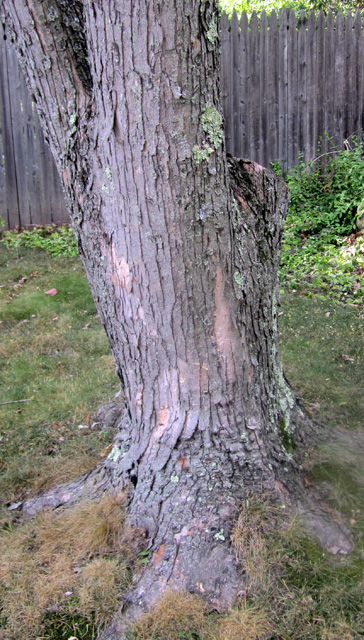 To see a full-resolution version of this photo, click on www.whitecanker.net/pictures/2010-07-31 Sick Silver Maple - 19 Briand.jpg (Left click to zoom in to a point, right click to save the picture to your PC or to print it.) This silver maple has lost more bark, and the lower area of bark loss even looks a bit rotten. In fact, if you look closely, the upper-left part of the trunk shows some signs of bleeding. 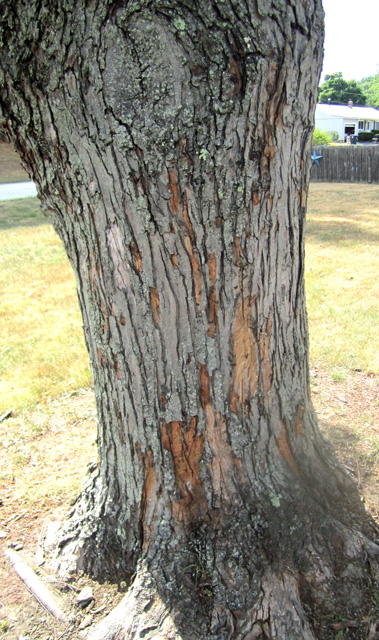 To see a full-resolution version of this photo, click on www.whitecanker.net/pictures/2010-07-31 Sick Silver Maple - 25 Briand.jpg (Left click to zoom in to a point, right click to save the picture to your PC or to print it.) This large silver maple has lost quite a bit of bark from its lower trunk. The bark loss has gotten progressively worse the past few years. 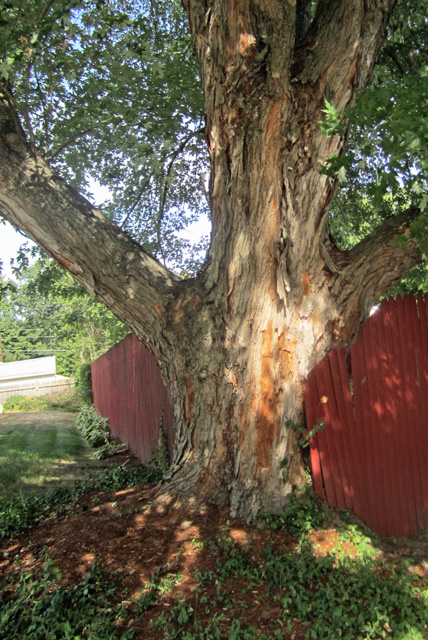 To see a full-resolution version of this photo, click on www.whitecanker.net/pictures/2010-07-31 Silver maple - 6 Sanborn.jpg (Left click to zoom in to a point, right click to save the picture to your PC or to print it.) So, over time, people may begin to wonder why these trees are called "silver" maples! |
||
|
10
on: July 26, 2010, 05:11:06 am
|
||
| Started by Don Peters - Last post by Don Peters | ||
|
If you've looked at as many silver maple trees over the past few years as I have, you may have noticed that they are changing in appearance. There appear to be two significant changes taking place. The first change is in the bark - it isn't as "silver" as it was in the past, and it seems to be falling off in spots, being replaced with a brown "under bark". The other change, responsible for the title of this posting, is that the canopy is getting thinner and thinner, and some leaves are turning yellow, curling up, and dropping off. Often the leaves will drop off a branch successively from the base to the tip, leaving just the branch tips with leaves. Note that this is NOT the typical "tar spot" that is causing this. Here is a picture of a stressed neighborhood silver maple tree:
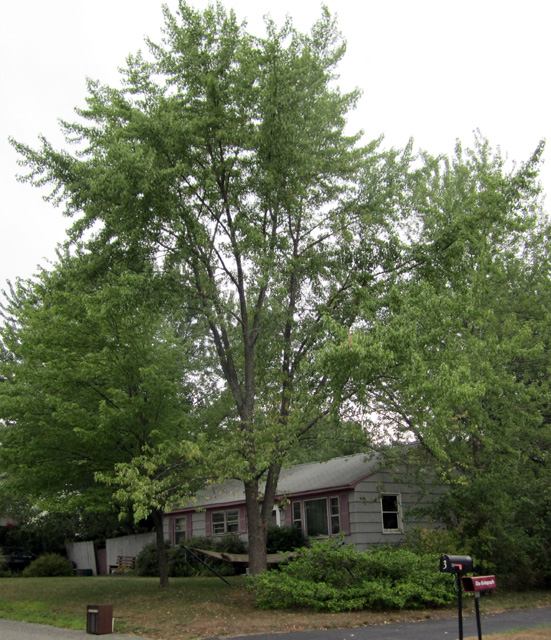 Given a quick glance, you'd think this tree is healthy. But note the yellowed leaves on the lower-left branch. Some of the leaves on this branch have curled up, turned brown, and fallen off. It's from this branch that I took a sample twig. Since a twig cross-section usually tells a lot about the condition of the tree, I took a series of 45 digital microscope images of the bark edge at 400x and stitched them together with Microsoft's ICE program, yielding the following composite image: 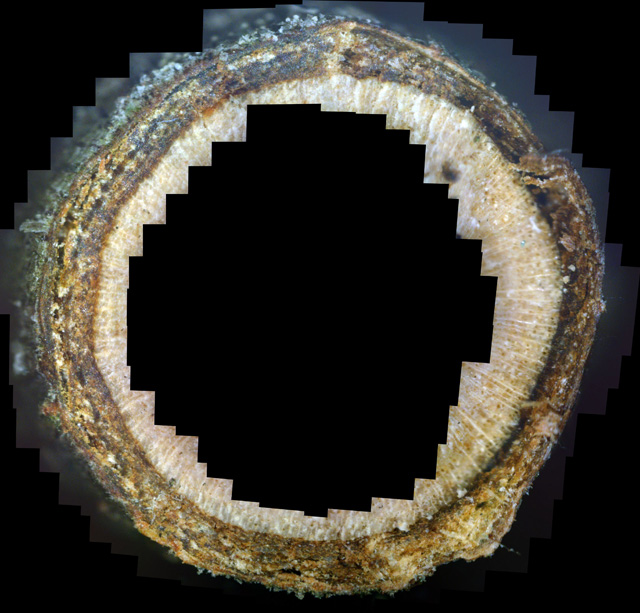 To get an even better appreciation of what this picture shows, check out the full resolution picture at: http://www.whitecanker.net/pictures/2010-07-25 Composite Silver maple twig cross-section.jpg (Click on a feature to zoom-in to it.) First and foremost, note the almost complete lack of green phloem, the tree tissue that transports the tree's nutrients! Instead, this green phloem has been replaced by dead tissue and white fungus material. It's no wonder the leaves are curling up and dying as if they are starving for water - they are! But watering the ground around the tree probably wouldn't do much good at all, as there is almost nothing left transport this water to the leaves. In addition, check out the xylem tissue below the phloem. It should be milk-white, but instead is a light brown, as if it, too, is dying. The large quantity of white blobs mixed in with the normal bark tissue give a strong indication that this tree is dying of white canker. |
||